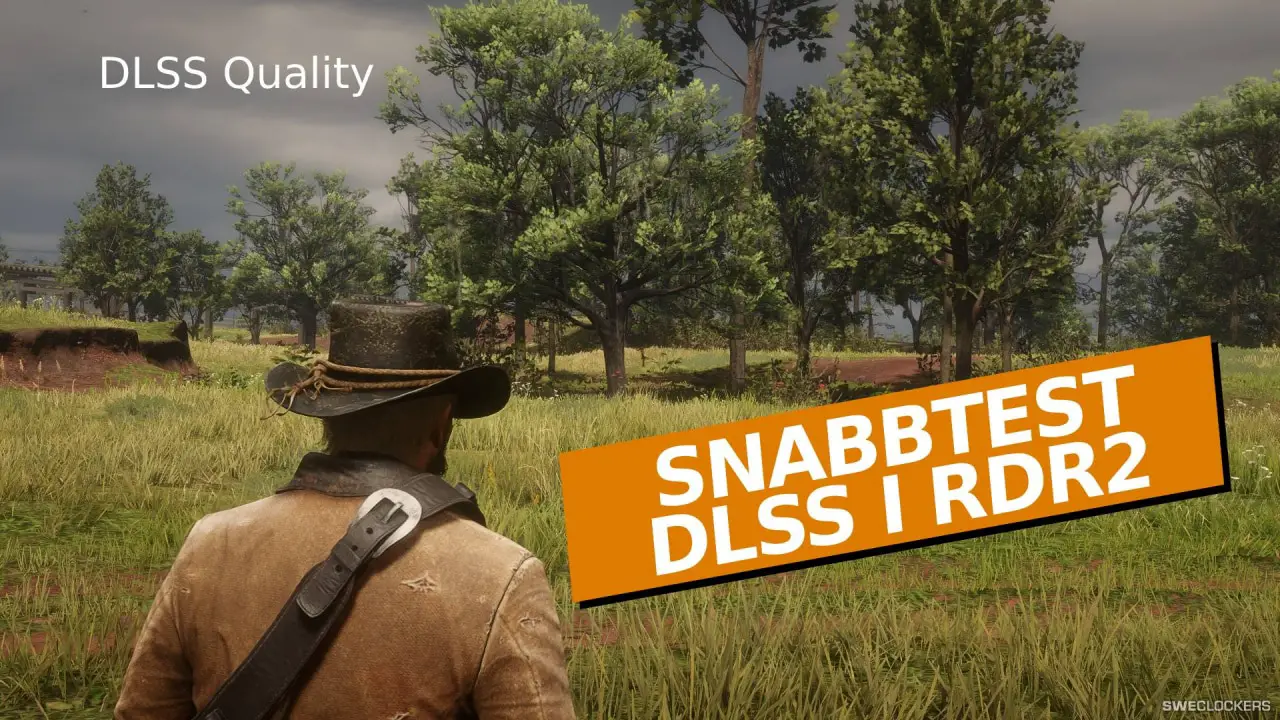Red Dead Redemption 2 is a relatively heavy-duty game in higher resolutions and the company’s TAA implementation has had to endure some criticism for its blur. In other words, this should be a prime candidate for Nvidia’s AI upscaling technology DLSS.
For those who are curious, we can announce that the version of DLSS that is shipped in the game’s latest patch is DLSS 2.2. The version number is identical to the dll file that came with Rust’s latest patch. This means that motion artifacts are significantly more uncommon than before, but that this can possibly happen at a certain cost of sharpness in the image.
Prestandatester
We paired a Ryzen 9 5900X with a Geforce RTX 3080 and tested the majority of the game’s anti-aliasing settings in three resolutions. Of course, we have also taken the opportunity to capture screenshots from each setting so that you can get an overview of how it affects image quality.
1,920 × 1,080 pixels | 2,560 × 1,440 pixels | 3,840 × 2,160 pixels | |
|---|---|---|---|
Native (4× MSAA) | 98/78 | 76/62 | 46/40 |
Native (No AA) | 127/98 | 104/83 | 71/59 |
Native (TAA) | 127/98 | 104/83 | 71/59 |
DLSS Quality | 141/109 | 116/91 | 85/71 |
DLSS Balanced | 143/109 | 123/98 | 92/76 |
DLSS Performance | 148/110 | 131/100 | 97/81 |
We start with old fashioned Multi Sampled Anti Aliasing (MSAA) set to four samples. With a high-performance card like the Geforce RTX 3080, the setting works in both 1080p and 1440p, but in 4K it gets crazy heavy.
Without anti-aliasing, we get significantly nicer performance and we can also state here that Rockstar’s TAA is extremely performance efficient as it does not reduce performance in a measurable way. However, it has other consequences that we address below when we talk image quality.
With DLSS activated, we see performance improvements that are between about 11 percent and all the way up to 36.6 percent. We do not reach all the way up to Nvidia’s alleged 45 percent with DLSS Performance in 4K, but we also do not know exactly which scenario or with which settings they tested.
As can be seen, with an RTX 3080, we are bottled up by factors other than resolution in 1080p, which means that there is no greater reason to use the lower levels of upscaling technology. In the higher resolutions, there is all the more reason to indulge in more aggressive settings, especially with those who have a leaner card from Nvidia’s RTX series.
Image quality
In the image quality comparisons, it becomes clear why many people complained about the game’s default setting with TAA. It makes the image so blurry that it is reminiscent of past Quincunx Anti Aliasing. The texture of Arthur’s hat, jacket and not least the belt buckle are obvious losers. In motion, the effect is significantly worse than what can be shown in still images as well.
If we turn off edge smoothing, we get a much sharper image, but to do it completely is not recommended. The game contains very small details in the world’s vegetation and becomes like a shimmering sea of unrest without leveling.
With MSAA activated, we get a relatively competent edge leveling, but details in tree crowns and grass are still experienced as a little worried. These may be alpha textures that MSAA has difficulty dealing with. As can be seen in the performance tests, it is also very cumbersome.
DLSS provides a good combination of sharpness, competent edge smoothing with calm in the image and of course the highest performance of the tested modes. It is not quite as sharp as native resolution with MSAA or without anti-aliasing, but it provides a better anti-aliasing and we avoid moiré patterns in highly detailed textures such as Arthur’s jacket.
However, not everything is gold and green forests. At lower resolutions or with DLSS set to Performance, “halo” / “ringing” effects begin to appear at contrast-rich breakpoints in the image, which is typical of sharpening filters but can also affect temporal upscaling solutions. For example, it can be seen quite clearly at Arthus’ hat.
The game’s built-in upscaling
Given the same conditions as DLSS Performance, ie an internal resolution of 50 percent of the target resolution, it becomes quite obvious how much better modern upscaling algorithms can be than older ditons. In motion, the comparison gets even worse where the traditional upscaling is extremely troubling while DLSS maintains most of the calm.
Closing words
Normally, we have been a little hesitant about DLSS in 1080p or too aggressively tuned DLSS for example. But in Red Dead Redemption 2, it is usually preferable to all other options almost no matter what combinations of resolutions and settings we test.
As I said, we do not quite reach Nvidia’s alleged 45 percent performance increase, but even when we are around 19 to 37 percent increased performance, it is enough to make a noticeable difference.
If you have a card with support for DLSS, we can recommend using it even if you do not even need the performance as the resulting image quality can often be better than the alternatives, especially when we talk about higher resolutions in combination with DLSS Quality for example. You definitely give up a certain amount of sharpness in the image set against nativeresolution without TAA, but in return you get superb edge smoothing and a greater calm in the image.
Have you tested DLSS in Red Dead Redemption 2? Share your experiences in the comment thread!















